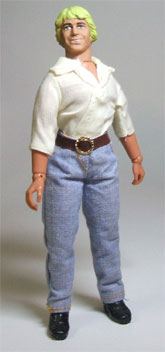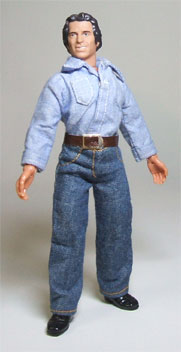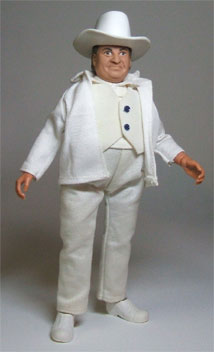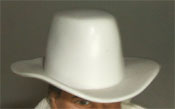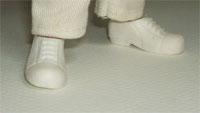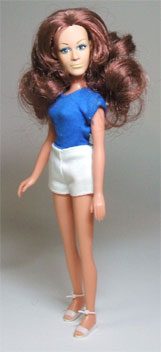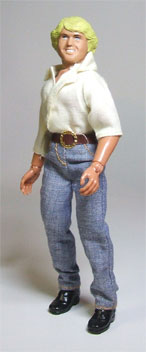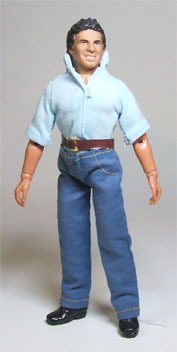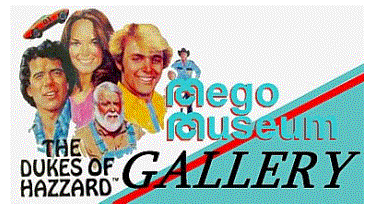
The Dukes of Hazzard first appears in the 1981 Mego catalog. Mego paid a mere $2,500.00 to acquire the Dukes of Hazzard license. The line became surprisingly popular and sold well due to the Dukes of Hazzard television show, which ranked as high as number 2 in the Nielsen ratings. Unfortunately, even this unforeseen popularity was not enough to save the floundering company.
The 81 line consisted of only four figures with two temporary additions, but is filled with numerous variations to keep hard core Dukes of Hazzard collectors busy.
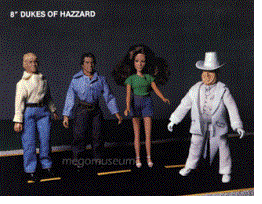 The image in the 1981 catalog showcases the four 8″ figures. The Luke, Bo and Daisy figures appear as they were initially sold at retail, but the Boss Hogg figure hardly resembles the marketed figure and is very interesting for many reasons. See the Boss Hogg section for details on this figure and the possible reasoning behind it.
The image in the 1981 catalog showcases the four 8″ figures. The Luke, Bo and Daisy figures appear as they were initially sold at retail, but the Boss Hogg figure hardly resembles the marketed figure and is very interesting for many reasons. See the Boss Hogg section for details on this figure and the possible reasoning behind it.
Kids and collectors were puzzled as to why Mego never made the General Lee car for the 8 inch figures. Some people have bought the 11 inch General Lee car under the impression it was for the 8 inch figures…Don’t do that. This is an odd omission since the whole point of the show was racing around in the General Lee. One wonders why Mego didn’t simply repaint the Starsky and Hutch Torino car. With the 8″ format giving way to the 3-3/4″ format, there were no accessories or playsets produced for the 8″ figures.
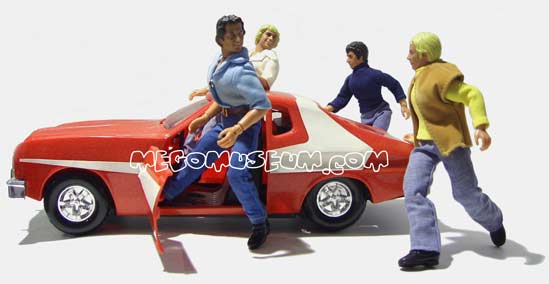
Dukes of Hazzard Packaging
The 8″ Dukes of Hazzard figures were all packaged on blister cards measuring 8-1/2″ x 10-5/16″ and featured fantastic illustrations of the characters related to the show. It even possibly confused and tortured children/collectors by featuring Uncle Jesse and Rosco P Coltrane, who were never offered in the 8″ format. With no checklist of figures reflected anywhere on the packaging, parents or children had no idea what figures were actually available and could have been searching endlessly for characters that never existed with no chance to succeed. The card design was the same for every figure differing only by the character’s name and item number on the front.
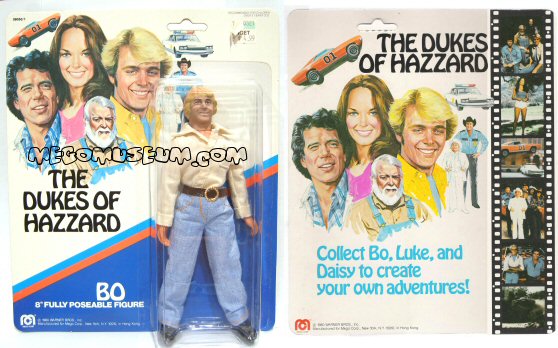
The artwork on the back of the cards was identical for every character with no character specific information. The back featured the same illustration as the front, but smaller. A film-strip ran down the right side of the card with actual photos from the show. The only non copyright text on the back was: “The Dukes of Hazzard” and “Collect Bo, Luke, and Daisy to create your own adventures!”
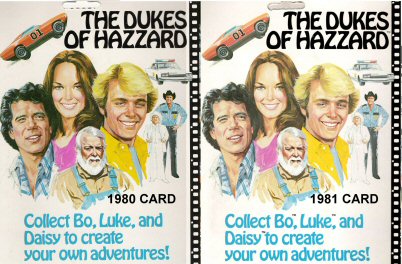
There is only one card variation that exists for Bo, Luke, and Daisy. Only minor text changes were made to the copyright statements by adding the registered trademark symbols to the line and character names. When the figures were introduced, initial cards reflected a 1980 copyright date. The main reason for the card revision was to add Copyright/trademark symbols when the show and character’s names were mentioned on the card.
The revised cards now reflected a 1981 copyright date. The 1980 and 1981 cards both have two lines of copyright text located at the bottom left corner of the cards. The top line on the 1980 card is significantly shorter when compared to the top line of the 1981 card. It is possible to distinguish between the two cards without being able to read the text.
The easiest way to differentiate between the 1980 and 1981 is by the copyright text located in the lower left corner of the card. The text reads:
1980 card:
The copyright information reads:
1980 WARNER BROTHERS., Inc.
Manufactured for Mego Corp., New York, N.Y. 10010, in Hong Kong
1981 card:
The copyright information reads:
TM Indicates trademark of WARNER BROTHERS INC. ‹1981
Manufactured for Mego Corp., New York, N.Y. 10010, in Hong Kong

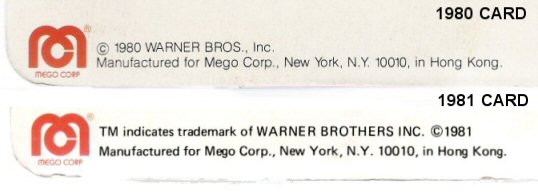
The text doesn’t even have to be legible to differentiate between the cards. The top line of text on the 1980 card is much shorter than the bottom line so as long as you can see the two lines of text, you can tell which card it is. The back bottom left corner of the card features the same text respectively. The majority of cards remaining are the 1981 cards.1980 cards can be found, but are more difficult to find when compared to the 1981 cards. With such a slight difference between the cards, most collectors will not pursue one particular version over another.
Even though the Dukes of Hazzard line was introduced in the twilight of Mego’s existence, the figures were all well done. For Mego and Dukes and of Hazzard collectors, all the figures can be found loose and packaged at very reasonable prices. The limited amount of characters, with numerous variations do create a challenge that is very obtainable if pursued. It is somewhat sad to realize that this was the last 8″ line Mego introduced and sold at the retail level. That alone does adds some nostalgic ties to collecting these figures.
Bo Duke was initially released wearing a long sleeve off-white denim shirt, denim blue jeans with a brown vinyl belt and a circular gold belt buckle. He also came with black high top boots. The Bo Duke head sculpt is dead on and clearly resembles John Schneider who played Bo Duke on the television series.
Bo’s long sleeve shirt contained a sewn in pocket located on his left breast and also contained one set of snaps in the front. Similar to Luke, Mego quickly modified Bo’s shirt by eliminating the pocket and shortening his sleeves. It could have been a cost cutting measure, or giving the figure more flexibility by having the elbows open for unrestricted movement. The shirt was modified while the 1980 cards were still in production so Bo can be found wearing a short sleeve shirt packaged in 1980 and 1981 cards (see the card section for details on the 1980 card.
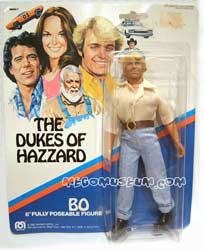
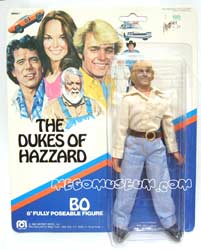
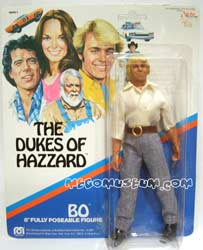
Bo with log sleeve and short sleeves on 1980 and 1981 cards
When Mego shortened the sleeves on Bo’s shirt, they also slightly changed the material and design. The long sleeve shirt was constructed from a thicker denim-like material. The short sleeve shirt was constructed from slightly thinner denim-like material, but was not the softer more elastic material used on Luke Duke shirts. The pocket located on the left breast was also removed. The majority of Bo Duke figures contain this later style shirt. The short sleeve shirt was also a bit “whiter” than the long sleeve shirt shown to the right.
The long sleeve shirt was designed so that the left side of the shirt snapped over the right side. The left side contained a lapel that ran down the center of the shirt when snapped. This lapel was eliminated when the short sleeve shirt was designed. Now that the short sleeve shirt was a symmetrical design, technically either side could be snapped over the other. While the majority of short sleeve shirts have the left side snapping over the right, some were produced so that the right side snaps over the left. The shirt with the right side snapped over the left is much more difficult to find, although this is only the result of someone sewing the snap to the other side to break the monotony on the production line.
Bo Duke’s short sleeve shirts can also exhibit an unattractive discoloring. Quite a few of the short sleeve shirts can have a brownish discoloration to them. Whether it is a chemical reaction with the body resin or some chemical in the shirt itself, it is not pleasant to look at. Carded Bo’s can be seen with discolored shirts still sealed inside original bubbles. Finding a vibrant white shirt without discoloration will not require an extended search, but the discolored shirts are out there in numbers
Bo’s initial blue jeans were not baggy and had more of a taped or snug fit (for the ladies) when compared to initial Luke Duke pants.
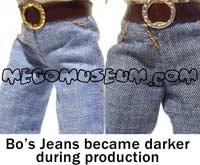 While the material for Luke Duke pants was changed from the denim-like material, Bo’s jeans continued to contain the denim-like material for the life of the line. The only difference was that the color of Bo’s jeans became a bit darker. The initial light blue denim pants can be paired with the long and short sleeve shirt. The later darker jeans should only be paired with the short sleeve shirt. There will be some slight variance upon close examination, but there was not the wide variance seen with Luke Duke pants.
While the material for Luke Duke pants was changed from the denim-like material, Bo’s jeans continued to contain the denim-like material for the life of the line. The only difference was that the color of Bo’s jeans became a bit darker. The initial light blue denim pants can be paired with the long and short sleeve shirt. The later darker jeans should only be paired with the short sleeve shirt. There will be some slight variance upon close examination, but there was not the wide variance seen with Luke Duke pants.
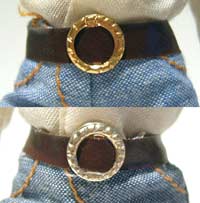 Bo’s pants were held up with a brown vinyl like belt sewn in at the ends by the snaps. A circular shaped belt buckle was threaded through the belt and was able to slide along the belt from end to end. The brown belts can be textured or smooth similar to Luke. The shape of Bo’s belt buckle did not change like Luke’s, although there is one variation. Similar to Luke, very few belt buckles have been confirmed to be silver rather than gold. It is possible that these silver belt buckles did not go through the gold dipping process. The silver belt buckles can be considered an error, but are very difficult to find and seldom pop up. To date, Bo has only been confirmed with the circular belt buckle, but with Quality Control not being Mego’s strength during their desperate times, it would not be unheard of to find some figures that were assembled with Luke’s belt buckle.
Bo’s pants were held up with a brown vinyl like belt sewn in at the ends by the snaps. A circular shaped belt buckle was threaded through the belt and was able to slide along the belt from end to end. The brown belts can be textured or smooth similar to Luke. The shape of Bo’s belt buckle did not change like Luke’s, although there is one variation. Similar to Luke, very few belt buckles have been confirmed to be silver rather than gold. It is possible that these silver belt buckles did not go through the gold dipping process. The silver belt buckles can be considered an error, but are very difficult to find and seldom pop up. To date, Bo has only been confirmed with the circular belt buckle, but with Quality Control not being Mego’s strength during their desperate times, it would not be unheard of to find some figures that were assembled with Luke’s belt buckle.
Similar to the short sleeve shirt, the waistline of the pants was symmetrical so either the side could be snapped over the other. Pants seemed to flip back and forth between right side over left, and vice versa.
The snaps used to secure the shirt and pants were initially metal snaps that can be shaped square or round. Shortly after the long sleeve shirt was phased out, the metal snaps were replaced with white plastic snaps. Since short sleeve shirts can be found with metal snaps, it is safe to say that all long sleeve shirts should only contain metal snaps. The short sleeve shirt can contain either metal or plastic snaps.
Similar to the short sleeve shirt, the waistline of the pants was symmetrical so either the right side could be snapped over the other. Pants seemed to flip back and forth between right side over left, and vice versa. See the picture a little further down for examples of pants sewn either way.
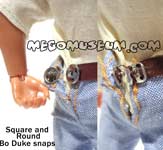 The snaps used to secure the shirt and pants were initially metal snaps that can be shaped square or round. Shortly after the long sleeve shirt was modified, the metal snaps were replaced with white plastic snaps. Since short sleeve shirts and the polyester type pants can be found with metal snaps, it is safe to say that all long sleeve shirts and baggy jeans should only contain metal snaps. The short sleeve shirt and polyester type pants can contain either metal or plastic snaps.
The snaps used to secure the shirt and pants were initially metal snaps that can be shaped square or round. Shortly after the long sleeve shirt was modified, the metal snaps were replaced with white plastic snaps. Since short sleeve shirts and the polyester type pants can be found with metal snaps, it is safe to say that all long sleeve shirts and baggy jeans should only contain metal snaps. The short sleeve shirt and polyester type pants can contain either metal or plastic snaps.
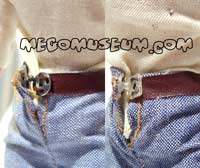
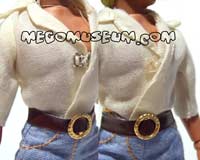
Metal and plastic snaps can be found on Bo’s shirts and pants.
Many more short sleeve shirts and pants with plastic snaps were produced compared to the short sleeve and lighter denim type pants with plastic snaps. The majority of collectors does not care or differentiate between the plastic and metal snaps. All versions can be found with persistence.
The thread used to secure the snaps to Bo’s shirt was initially white and designed to match the shirt color. Since the thread color is very visible, both Bo and Luke shirts have snaps sewn to the shirts with thread targeted to match the shirt color. It would not be unheard of to see a Bo shirt containing a thread color other than white. This would be rare, but don’t throw it on E-Bay yet, as it probably will not make a difference in value. The thread used to secure the snaps to Bo’s pants was initially brown. You can see below how the thread color varied so much for Luke’s pants, but why was this not the case for Bo’s pants? It seems that only brown thread was used to sew the snaps to Bo’s pants. It would not be a shock and almost make more sense to see some Bo pants have snaps sewn with different color thread, but again it will have just about no impact of the value. You may even see an E-Bay auction advertising their loose
The various thread colors used for Luke’s pants are shockingly non existent for Bo’s pants.

Bo figure with the “the SUPER RARE Bo figure with red thread”. Go check out your loose Bo’s pants to see what color thread you have!
Graying Head
Bo and Luke heads are notorious for turning gray or discoloring. A large number of Bo and Luke heads have that ugly gray appearance also commonly seen on other later 8″ figures. Bo can have a gray head inside a 1980 or 1981 cards. The entire head can be gray or even just portions of the head can be gray. Towards the very end, Mego solved the graying issue as tail end Dukes of Hazzard figures and all 8″ heads no longer discolored to become gray. Finding a carded Bo or Luke without a gray head and on a high grade card can be done, but it is not that easy. When one becomes available for sale, the price usually is higher than normal.
All the Bo Duke variations can be found and will not cause you to skip a car payment to purchase them. High-grade cards with non-gray heads will command higher prices, but never cross the $100 threshold.
Luke Duke was initially released wearing a long sleeve light blue denim shirt, denim blue jeans with a brown vinyl belt and rectangular gold belt buckle. He also came with black high top boots. The Luke Duke head sculpt is dead on and clearly resembles Tom Wopat who played Luke Duke on the television series.
Luke’s long sleeve shirt contained a sewn in pocket located on his right breast and also contained one set of snaps in the front. Similar to Bo, Mego quickly modified Luke’s shirt by eliminating the pocket and shortening his sleeves. It could have been a cost cutting measure, or giving the figure more flexibility by having the elbows open for unrestricted movement. The shirt was modified while the 1980 cards were still being used so Luke can be found wearing a short sleeve shirt packaged in 1980 and 1981 cards (see the main Dukes page for details on the 1980 card).
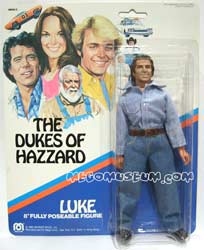
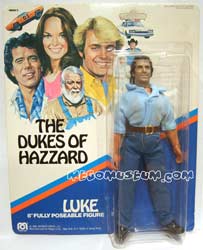
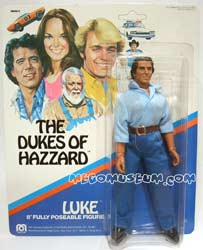
(Above) Luke with log sleeve and short sleeves on 1980 and 1981
cards

When Mego shortened the sleeves on Luke’s shirt, they also changed the material and design. The long sleeve shirt was constructed from a thicker denim-like material. The short sleeve shirt was constructed from a softer more elastic light blue material. The pocket located on the right breast was also removed. The majority of Luke Duke figures contain this later style shirt.

The long sleeve shirt was designed so that the left side of the shirt snapped over the right side. The left side contained a lapel that ran down the center of the shirt when snapped. This lapel was eliminated when the short sleeve shirt was designed. Now that the short sleeve shirt was a symmetrical design, technically either side could be snapped over the other. While the majority of short sleeve shirts have the left side snapped over the right, some were produced so that the right side snaps over the left. Here are examples of Luke Duke shirts on Vance with the left side snapped over the right and vice versa. The Luke Duke shirt with the right side snapped over the left is much more difficult to find, although this is only the result of someone sewing the snap to the other side to break the monotony on the production line.
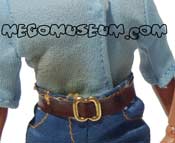
Luke Duke’s short sleeve shirts can also exhibit an unattractive discoloring. Quite a few of the short sleeve shirts can have a brownish discoloration to them. Whether it is a chemical reaction to the body resin or some chemical in the shirt itself, it is not pleasant to look at. Carded Lukes can be seen with discolored shirts still sealed inside original bubbles. Finding a vibrant blue shirt without discoloration will not require an extended search, but the discolored shirts are out there in numbers.
Luke’s blue jeans were initially baggy (or relaxed fit), and constructed from a denim like material with metal snaps. This material was a bit darker and thicker than Bo’s pants. The material of Luke’s jeans changed the same time as the shirt was modified.
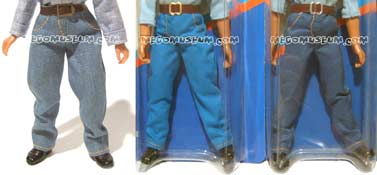 The pant material was switched to a darker blue polyester material. The modified jeans no longer contained that denim texture and were now a solid blue polyester type blue material. This material was thinner and most likely less expensive. The color of the polyester type pant material can vary upon close inspection. A more significant color variation does exist. Some Lukes will have very bright blue pants. This was probably not an intentional change, but most likely just variance among the material or availability. These pants are too bright and almost look like pajamas. These bright blue pants were produced in limited quantities when compared to the darker blue pants and are somewhat difficult to find. The initial blue denim pants are the rarest of three versions. Either color of the polyester pants can be found with the bright blue pants being more difficult to find.
The pant material was switched to a darker blue polyester material. The modified jeans no longer contained that denim texture and were now a solid blue polyester type blue material. This material was thinner and most likely less expensive. The color of the polyester type pant material can vary upon close inspection. A more significant color variation does exist. Some Lukes will have very bright blue pants. This was probably not an intentional change, but most likely just variance among the material or availability. These pants are too bright and almost look like pajamas. These bright blue pants were produced in limited quantities when compared to the darker blue pants and are somewhat difficult to find. The initial blue denim pants are the rarest of three versions. Either color of the polyester pants can be found with the bright blue pants being more difficult to find.
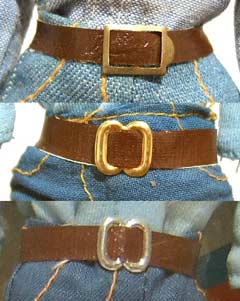 Luke’s pants were held up with a brown vinyl like belt sewn in at the ends by the snaps. A rectangular shaped belt buckle was threaded through the belt and was able to slide along the belt from end to end. All of the baggy denim pants contained this rectangular belt. The brown belts can be textured as pictured with the square belt buckle, and also smooth as pictured with the later belt buckle. When the pant material was switched to a polyester type material, the belt buckle also changed. The belt buckle for the polyester pants was square shaped with the top and bottom having an “arc” to it. One variation of this belt buckle does exist. Very few curved belt buckles have been confirmed to be silver rather than gold. It is possible that these silver belt buckles did not go through the gold dipping process. The silver belt buckles can be considered an error, but are very difficult to find and seldom pop up. To date, Luke Duke has only been confirmed with these three belt buckles, but with Quality Control not being Mego’s strength during their desparate times, it would not be unheard of to find some figures that were assembled with Bo’s belt buckle. Similar to the short sleeve shirt, the waistline of the pants was symmetrical so either the right side could be snapped over the other. Pants seemed to flip back and forth between right side over left, and vice versa. See the picture a little further down for examples of pants sewn either way.
Luke’s pants were held up with a brown vinyl like belt sewn in at the ends by the snaps. A rectangular shaped belt buckle was threaded through the belt and was able to slide along the belt from end to end. All of the baggy denim pants contained this rectangular belt. The brown belts can be textured as pictured with the square belt buckle, and also smooth as pictured with the later belt buckle. When the pant material was switched to a polyester type material, the belt buckle also changed. The belt buckle for the polyester pants was square shaped with the top and bottom having an “arc” to it. One variation of this belt buckle does exist. Very few curved belt buckles have been confirmed to be silver rather than gold. It is possible that these silver belt buckles did not go through the gold dipping process. The silver belt buckles can be considered an error, but are very difficult to find and seldom pop up. To date, Luke Duke has only been confirmed with these three belt buckles, but with Quality Control not being Mego’s strength during their desparate times, it would not be unheard of to find some figures that were assembled with Bo’s belt buckle. Similar to the short sleeve shirt, the waistline of the pants was symmetrical so either the right side could be snapped over the other. Pants seemed to flip back and forth between right side over left, and vice versa. See the picture a little further down for examples of pants sewn either way.
The snaps used to secure the shirt and pants were initially metal snaps that can be shaped square or round. Shortly after the long sleeve shirt was modified, the metal snaps were replaced with white plastic snaps. Since short sleeve shirts and the polyester type pants can be found with metal snaps, it is safe to say that all long sleeve shirts and baggy jeans should only contain metal snaps. The short sleeve shirt and polyester type pants can contain either metal or plastic snaps.
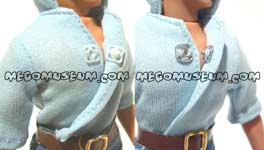

Many more short sleeve shirts and pants with plastic snaps were produced compared to the short sleeve and polyester type pants with plastic snaps. The majority of collectors do not care or differentiate between the plastic and metal snaps. All versions can be found with persistence.
The thread used to secure the snaps to the shirt and pants can vary. Unlike the brown thread that was consistently used for Bo figures, the thread color for Luke snaps can vary widely. Initial Luke Duke outfits had the shirt snaps sewn with a light blue/gray thread and the pants with brown thread to match the belt.

The various snaps and color threads used for Luke’s pants can create numerous combinations.
Once the shirt and pants were modified, it seems like they used whatever thread was closest. The thread used to secure the snap to the shirt was consistently light blue to match the shirt color, but the thread used to secure the snap to the pants varied significantly. White, light blue, blue, brown, and yellow are some of the colors that were used and pictured below. It can be theorized that white was for Bo’s shirt, the light blue matched the short sleeve Luke shirt, the blue matched the later light blue pants, the brown matched the belt, and the yellow was the same thread used to sew the pockets on the pants. It would not be shocking to see pants that contained even more colors since it is such a minor variation and hardly detectable. Go look at your Luke pants now to see what color you have!!!
Graying Heads
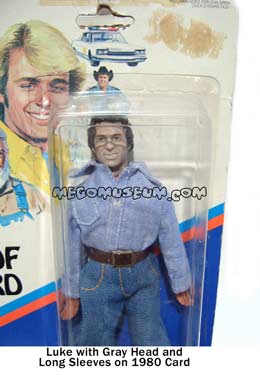 Bo and Luke heads are notorious for turning gray or discoloring. A large number of Bo and Luke heads have that ugly gray appearance also commonly seen on other later 8″ figures. Luke can have a gray head inside a 1980 or 1981 cards. The entire head can be gray or even just portions of the head can be gray. Towards the very end, Mego solved the graying issue as tail end Dukes of Hazzard figures and all 8″ heads no longer discolored to become gray. Finding a carded Bo or Luke without a gray head and on a high grade card can be done, but it is not that easy. When one becomes available for sale, the price usually is higher than normal.
Bo and Luke heads are notorious for turning gray or discoloring. A large number of Bo and Luke heads have that ugly gray appearance also commonly seen on other later 8″ figures. Luke can have a gray head inside a 1980 or 1981 cards. The entire head can be gray or even just portions of the head can be gray. Towards the very end, Mego solved the graying issue as tail end Dukes of Hazzard figures and all 8″ heads no longer discolored to become gray. Finding a carded Bo or Luke without a gray head and on a high grade card can be done, but it is not that easy. When one becomes available for sale, the price usually is higher than normal.
All the Luke Duke variations can be found and will not cause you to skip a mortgage payment to purchase them. High grade cards with non gray heads will command higher prices, but never cross the $100 threshold.
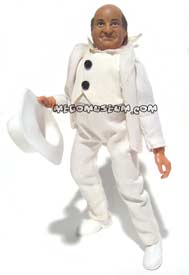
Boss Hogg was the fourth character within the 8″ Dukes of Hazzard Line and was initially released wearing his classic white suit and vest. The outfit was sleeveless with a felt-like white vest with two buttons sewn in. A white bow tie was also stitched by the neckline. He wore a white blazer and came with white shoes, which were the same shoes used for the 8″ Penguin and Joker, but molded in white. Boss Hogg would not be complete without his soft rubber white cowboy hat. Boss Hogg only came on the type 2 pot-bellied body type also shared by the likes of Penguin, Mr. Mxyzptlk, and the Wizard from the Wizard of OZ (except with flesh colored hands).
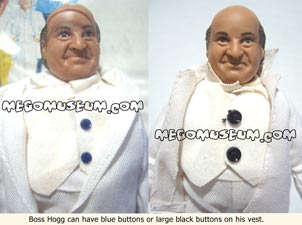 Boss Hogg is a well done figure and nails the likeness of Boss Hogg played by Sorrell Booke. A testament to the accuracy of this figure is the lack of variations. There are only two minor variations for Boss Hogg. The first is the change from metal snaps to white plastic snaps for the outfit. The second variation has to do with the buttons. Boss Hogg’s vest buttons can be blue or black. The size can also vary as shown to the left. The smaller blue buttons are commonly seen, but the large black buttons are much scarcer. Having a Boss
Boss Hogg is a well done figure and nails the likeness of Boss Hogg played by Sorrell Booke. A testament to the accuracy of this figure is the lack of variations. There are only two minor variations for Boss Hogg. The first is the change from metal snaps to white plastic snaps for the outfit. The second variation has to do with the buttons. Boss Hogg’s vest buttons can be blue or black. The size can also vary as shown to the left. The smaller blue buttons are commonly seen, but the large black buttons are much scarcer. Having a Boss
Hogg with the rarer large snaps, will most likely have no impact on value to anyone other than Sorrell Booke. Aside from the buttons and snap variations, the Boss Hogg figure remained unchanged throughout production. Boss Hogg is very easy to find loose and carded. With many carded Boss Hoggs on shelves for long periods of time and eventually marked down as clearance, high-grade cards do not pop up often.
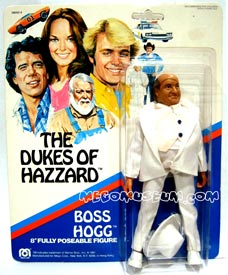 The majority of loose Boss Hoggs no longer have pristine white outfits, and even some carded Boss Hoggs can exhibit yellowed outfits while still sealed inside the blister. A loose Boss Hogg needs to be wearing a bright white outfit and blazer. Boss Hogg would never settle on wearing a yellowed or dirty outfit. Boss Hogg was packaged on blister
The majority of loose Boss Hoggs no longer have pristine white outfits, and even some carded Boss Hoggs can exhibit yellowed outfits while still sealed inside the blister. A loose Boss Hogg needs to be wearing a bright white outfit and blazer. Boss Hogg would never settle on wearing a yellowed or dirty outfit. Boss Hogg was packaged on blister
cards with his hat in a plastic bag and placed by his feet (unless you are holding the card upside down, then the hat would be by his head). If a carded Boss Hogg has the hat on inside the bubble, or not sealed in a bag, those darn Dukes were at it again because something is not right.
Boss Hogg only comes packaged on a 1981 card and never on a 1980 card. Even though Boss Hogg was
in the original 1981 Mego catalog when the line was first introduced, he was possibly introduced a bit later than Bo, Luke, and Daisy. It may be a surprise that Boss Hogg may not have been originally intended for the 8″ line or possibly a last minute addition. While this can’t be stated as an absolute fact, there are a few
facts which support this theory.
WAS BOSS HOGG ORIGINALLY INTENDED FOR THE 8″ LINE?
It can not be declared as fact, but it is possible that Boss Hogg was not initially intended to be part of the Dukes of Hazzard 8″ line. For whatever the reason, many facts do support the theory that Boss was a last minute addition to the 8″ line. Read the
following facts below and you be the jury.
Fact #1: The 1981 Mego Catalog
The 1981 Mego Catalog picture is the first appearance of the 8″ Dukes of Hazzard figures. Luke, Bo and Daisy all represented the
production figures which initially hit toy shelves at retail in 1981. The head sculpts and outfits all match what was used for production,
and then there is Boss Hogg.
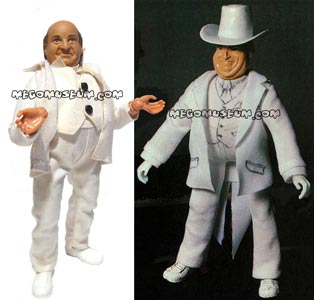
The Boss Hogg figure pictured in the 1981 catalog is nothing like the Boss Hogg initially
produced. The most disturbing thing about the Boss Hogg figure is that he is on a Type 1 body. This is not specific to Boss Hogg, but Type 1 bodies were phased out almost five years ago in 1976.
Why Boss Hogg appears on Type 1 body is unknown and very puzzling. This does not specifically support that Boss Hogg was a last minute addition, but only that Mego still had Type 1 bodies lying around the company as late as 1981. The head sculpt does not match what was eventually used in production and appears to be hand made sample. Boss Hogg’s outfit also appears to be a quick handmade prototype. The blazer in the 1981 catalog contained coat-tails and had pockets drawn in with black marker. The production blazer did not have coat-tails or pockets. You can see how the back bottom edge of the blazer and how the coat-tails are attached as separate pieces. The bow tie and vest were also drawn rather than the sewn in buttons and bow
tie eventually used in production. Since only the Boss Hogg figure differs from the figure used in production, it is possible that once the last minute decision to include Boss Hogg as part of the 8″ line was made, Mego scrambled to put something together to photograph for the catalog. If all four figures were developed
simultaneously, the Boss Hogg figure would have represented the production figures like the others. This alone does not prove the point, but keep reading.
Fact # 2: The figure item numbers
The item numbers for the 8″ Dukes of Hazzard figures are as follows:
Bo: 09050/1
Luke: 09050/2
Daisy: 09050/3
Boss Hogg: 09050/4
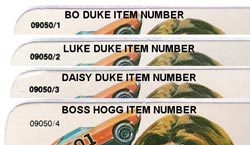 |
Boss Hogg’s item number is last in the sequence. If his item number was before any of the figures, it would disprove the theory that he was a last minute addition. Not only is Boss Hogg’s item number the last, it differs slightly in appearance on the card when compared to the others. The Bo, Luke and Daisy item numbers are identical except for the numbers themselves. The Boss Hogg item number is not as bold. It can be theorized that the Bo, Luke, and Daisy card artwork was created simultaneously and therefore have the exact appearance. It is possible that once the last minute decision to include Boss Hogg was made, his card artwork was created separately, but the item number appeared slightly different. Convinced yet? The card artwork also provides some insight, which is detailed in fact #3.
Fact #3: The card artwork
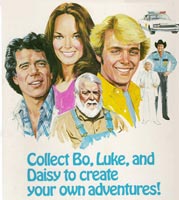 |
In addition to the item numbers, the card artwork has strong evidence to support that Boss Hogg was a last minute addition or possibly not originally intended to be part of the 8″ line. The Dukes of Hazzard image reflected on the card is very telling. Bo’s, Luke’s, and Daisy’s head are all the same size in the illustration. It can be interpreted that the largest illustrations were of figures intended for the line. Of the six characters, in the illustration, Boss Hogg is actually the smallest. Based on the image sizes, it would appear that Uncle Jesse would have been a figure before Boss Hogg.
To date, no Boss Hoggs have been confirmed on a 1980 card, only on 1981 cards. The Boss Hogg card is unique when compared to the other 1980 and 1981 cards. The text for the 1980 and 1981 cards are shown side by side with the Boss Hogg card. The text on the Boss Hogg card does match the 1981 cards with the exception of the Warner Brothers name not being all caps. It again supports that the Boss Hogg card was designed separately from the others and probably after the 1980 card, but before the 1981 card.
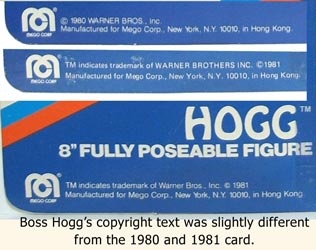

The most compelling evidence is in the text below the illustration. The text “Collect Bo, Luke, and Daisy to create your own adventures.”
is the same on the 1980 and 1981 cards for every character (even Boss Hogg’s). It is very possible that Boss Hogg was not part of the 8″ line when the 1980 card artwork was designed and not added to this statement. Even when the cards were revised to add the copyright and trademark symbols for the 1981 card, revising
this statement was most likely overlooked and didn’t change.
( Editors Note: It should also be mentioned that at the time, Mego seemed to be moving towards producing 8″ figures with no villain,
both Chips and the Greatest American Hero were sets of three good guys with no baddies to speak of)
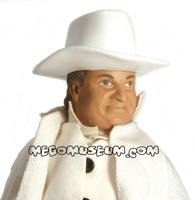 While it could never be declared a fact that Boss Hogg was not initially intended to be part of the 8″ Dukes of Hazzard line, the evidence stated above makes a very strong case. It was a good decision because what adventures can you have if there is no villain?
While it could never be declared a fact that Boss Hogg was not initially intended to be part of the 8″ Dukes of Hazzard line, the evidence stated above makes a very strong case. It was a good decision because what adventures can you have if there is no villain?
It is also interesting that no Boss Hogg figures have ever surfaced with gray heads. This might be pure coincidence and luck that the particular resin that discolors just was not used for molding Boss Hogg heads. This could be interpreted some way to also support that Boss Hogg was introduced later. Since Luke and Bo on 1980 cards can both have gray heads, and Boss Hogg only comes on a 1981 card, maybe Boss Hogg was introduced after the discoloring resin was used and exhausted. This may be a stretch, but the evidence above is much more sound than this. Let’s just say it was luck that no Boss Hogg heads ever turned gray.
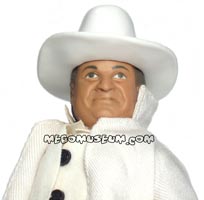 Boss Hogg, introduced later or at the same time as the other 8″ figures, is still very easy to find loose or carded. Damaged or worn cards are out there in great numbers to open and finally get
Boss Hogg, introduced later or at the same time as the other 8″ figures, is still very easy to find loose or carded. Damaged or worn cards are out there in great numbers to open and finally get
that mint loose Boss Hogg. Be careful though, because behind some of those yellowed bubbles might be a discolored outfit and not the pristine white outfit you expected. Carded Boss Hoggs are again easy to find, but high-grade cards are getting scarcer. Scarce or not, Boss Hogg will always remain well under the $100 threshold. The Mego Musuem would love to revise this last statement so keep buying.
Boss Hogg wears a white cowboy hat that is unique to the character and has not been factory reproduced.
Boss Hogg wears a white pair of dress shoes made from the same mold as the brown and black dress shoes found on many characters in the WGSH line and scattered through a few other lines. The white color is unique to the character, and while the black and brown versions have been factory reproduced, the white dress shoe has not, although Classic TV Toys does make a white sneaker that is somewhat similar in appearance.
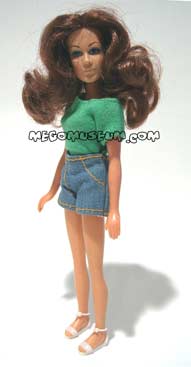 Daisy Duke was the third 8″ Dukes of Hazzard figure and was released initially wearing a green shirt and her infamous “Daisy Duke” blue denim shorts. She also came wearing white sandals. Daisy was only issued on the later style female body with unjointed wrists, elbows, and knees and was never produced with the 1st version female body containing jointed wrists, elbows, and knees
Daisy Duke was the third 8″ Dukes of Hazzard figure and was released initially wearing a green shirt and her infamous “Daisy Duke” blue denim shorts. She also came wearing white sandals. Daisy was only issued on the later style female body with unjointed wrists, elbows, and knees and was never produced with the 1st version female body containing jointed wrists, elbows, and knees
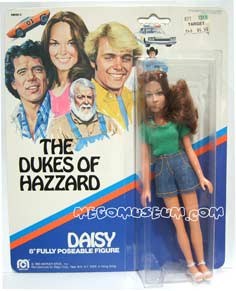
Daisy’s green shirt and blue shorts quickly changed to a blue shirt with white shorts. How could Mego get rid of the blue denim Daisy Duke shorts in favor of the white shorts? The photo of Daisy on the back of the card did have the blue shirt and white shorts, so maybe they wanted the figure to match what was pictured on the card. The majority of Daisy outfits contain the later blue shirt/white shorts. Finding a loose or carded Daisy with the initial green shirt and blue shorts can be done, but is not easy. Daisy with a green shirt/blue shorts will command higher prices when one becomes available for sale. The green shirt and blue shorts initially contained metal snaps similar to the other initial outfits for Bo, Luke, and Boss Hogg. It has not been confirmed, but most likely all green shirts and blue shorts contained metal snaps. Until a blue shirt with white shorts Daisy Duke is confirmed with metal snaps, this can not be stated as fact. Check your Daisy Dukes (I meant the figures) to see if your blue shirt or white shorts have metal snaps, notify the Museum immediately!
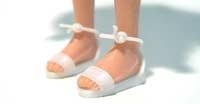 Daisy Duke came with white plastic sandals that were unfortunately very easy to lose. The very thin strap around the ankle made the sandals very fragile and prone to breaking. The majority of loose Daisy Dukes will not have sandals so the easiest route of getting them may be freeing a Daisy from a worn card.
Daisy Duke came with white plastic sandals that were unfortunately very easy to lose. The very thin strap around the ankle made the sandals very fragile and prone to breaking. The majority of loose Daisy Dukes will not have sandals so the easiest route of getting them may be freeing a Daisy from a worn card.
Daisy’s head sculpt pales in comparison to the other characters within the 8″ line. Bo, Luke, and Boss Hogg were all exquisite sculpts while Daisy hardly resembled Catherine Bach and seemed a bit too large for her body. Through fantastic detective work by James Brady, the reason for this lackluster sculpt was uncovered. Daisy’s head sculpt was simply a shrunken down version of the 12″ Wonder Woman Nubia sculpt. Read the amazing thread below to see how this unfolded and was solved.
The true origin of Daisy Duke
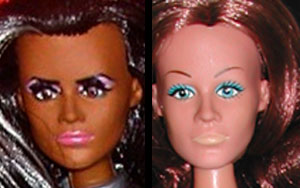

Daisy’s head can exhibit some discoloration, but different than the graying frequently seen on Luke and Bo. Some Daisy heads can be very pale or yellowish in color. This could be a chemical reaction, but whatever the reason, is very unpleasant to look at.
Daisy Duke comes packaged with a clear plastic band around her head to hold her hair in place. Once that plastic band came off, look out! That big head, with her very long hair creates a recipe for disaster. Some Daisy Dukes look as if she stuck a fork in an electrical socket not once, but twice. There is something to be said for a Dais
y Duke with neat hair or even the plastic band still around her head.
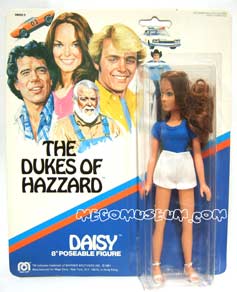 Daisy came packaged on a 1980 and 1981 card. The green shirt and blue shorts figures only appear on the 1980 card. The blue shirt and white shorts figures can come on a 1980 or 1981 card. A Daisy with the blue shirt/white shorts is very difficult to find on the 1980 card. Carded Daisy Dukes consistently command the highest values of any Dukes character with the exception of Vance. Daisy Duke was the very last 8″ female character that Mego ever produced. Most of the time, the Daisy Duke figure looks stiff and big headed, but when properly positioned, the figure can look decent. Who wouldn’t want a mini-Daisy Duke to play with? . The “Mego Dukes of Hazzard” Gallery would not have been possible without the fantastic contributions and assistance of Tom.
Daisy came packaged on a 1980 and 1981 card. The green shirt and blue shorts figures only appear on the 1980 card. The blue shirt and white shorts figures can come on a 1980 or 1981 card. A Daisy with the blue shirt/white shorts is very difficult to find on the 1980 card. Carded Daisy Dukes consistently command the highest values of any Dukes character with the exception of Vance. Daisy Duke was the very last 8″ female character that Mego ever produced. Most of the time, the Daisy Duke figure looks stiff and big headed, but when properly positioned, the figure can look decent. Who wouldn’t want a mini-Daisy Duke to play with? . The “Mego Dukes of Hazzard” Gallery would not have been possible without the fantastic contributions and assistance of Tom.
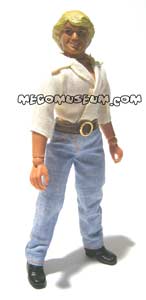 When
When
John Schneider and Tom Wopat abruptly left the show over a merchandising
dispute (which Mego was obviously a part of), the network scrambled
by having their cousins Coy and Vance
replace them. Coy was played by then well-known actor Byron Cherry
(insert sarcastic tone), while Christopher Mayer who was just as
famous, played Vance. Mego also responded by designing new head-sculpts
for both characters. New heads were sculpted, but the outfits and
packaging remained the same. Since Coy and Vance came on Bo and
Luke cards, no unique item numbers were assigned for the figures.
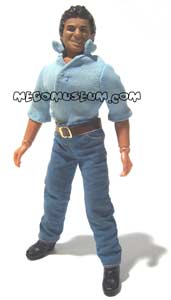
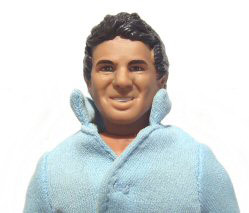
In addition to the 8″ figures, Mego also produced 3-3/4″
Coy and Vance figures. No “changes” were made with the
only difference being the chest portions of the shirts for Bo and
Luke were swapped. A 3-3/4″ Coy had blond hair, wore a blue
shirt, with blue pants. A 3-3/4″ Vance had brown hair, wore
a tan shirt with blue pants. The 3-3/4″ Coy and Vance are much
rarer than the 8″ versions and just about non-existent.
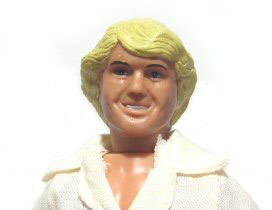
Mego never bothered to print new cards reflecting their names so
Coy was packaged in Bo’s card and Vance was packaged in Luke’s card.
This makes it somewhat difficult to identify a carded Coy and Vance
without a decent picture. It also can help in snagging a carded
Coy or Vance for a bargain.
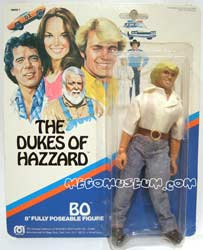
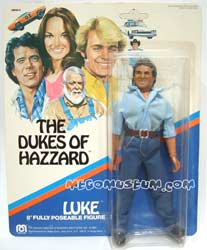
It is also interesting that unlike the 8″ figures, Mego decided
to sticker the blister cards for the 3-3/4″ Coy and Vance to
reflect the proper names. A small sticker bearing the Coy or Vance
name was placed over the existing name. The sticker had a blue background
to match the card color and the white text reflecting the figure’s
name.
Both but can still be found. Luke and 8″ figures were produced
in much smaller quantities and are much more difficult to find compared
to Bo and Luke, Bo worked out whatever monetary issues they had
and quickly came back to the show. Coy and Vance were gone as quick
as they came. It would make sense that both were packed at the same
ratio within a case, but for some reason Vance is much more difficult
to find than Coy.
With Coy and Vance’s fast entrance and exit, it is difficult to
pinpoint the exact timing. There are a few things that can generalize
the timing based on relative changes. Coy and Vance only came packaged
on 1981 cards. Coy and Vance should only appear wearing the short
sleeve shirts since they were introduced after the long sleeve shirts
with pocket were phased out.
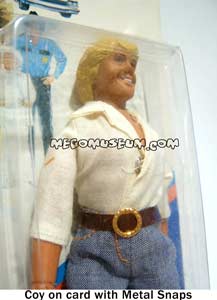 |
No Coy and Vance figures have been confirmed with gray heads,
so they were most likely introduced after the particular resin that
discolored to a “gray” color was used. A gray Coy and
Vance head if confirmed, would be very rare, but not the rare you
want. Maybe someone will now concoct a method for turning heads
gray? Coy and Vance can be found with metal and plastic
snaps on their shirts and pants. Evidence suggests that the transition
from metal to plastic snaps for the Dukes was not absolute and it
is very possible that metal snaps were used after plastic snaps
were already introduced. The majority of Coy and Vance figures will
contain plastic snaps, but Coy and Vance with metal snaps do exist
and are much more difficult to find. Pictured is a carded Coy with
metal snaps.
This may sound like a tongue twister, but here
is why components were most likely not completely exhausted before
their replacement was used. A Bo Duke can be found on a 1980 card
with short sleeves and plastic snaps. A Coy Duke can be found on
a 1981 card with short sleeves and metal snaps. If metal snaps preceded
plastic snaps and 1980 cards preceded 1981 cards, something had
to be re-introduced in order to have both combinations listed above.

Confused yet? The bottom line is,
aside from the long sleeve shirts and baggy Luke pants, all the
variations found on Bo and Luke figures can also be found on Coy
and Vance figures The Coy and Vance figures are unique in
the fact that they were two temporary additions to the 8″ Dukes
of Hazzard line. With no Coy and Vance item numbers, no packages
reflecting their name, and no appearance in the retail catalogs,
it almost seems like they never really existed. Coy and Vance are
the scarcest and most limited from a production quantity standpoint.
Coy is much easier to find, but Vance is probably the toughest figure
of all the 8″ Dukes figures to find loose and carded.
The Duke Boys wear boots that can also be found on the Fonz from the Happy Days line, Huggy Bear from Starsky and Hutch and sometimes on Hutch himself. These boots have been reproduced by CTVT. The reproductions, while the same height are thicker with a wider foot opening. They have a rough texture to them as well. They are unmarked.

By the late nineteen seventies, most sandboxes were being filled figures in the 3 3/4″ format.
Mego, who was once the market leader with the 8″ format simply followed suit and produced most of their toy licenses as 3 3/4″ figures including CHiPs and sci fi efforts such as Buck Rogers
What is unique about these figures is that unlike many of the other 3 3/4″ Mego lines, the Dukes don’t seem to fit any one body style but seem to use bits and pieces from all of Mego’s other lines.
The Mego 3 3/4″ Dukes line was a runaway hit and sold enough to warrant a second series, vehicles and (almost) a playset!
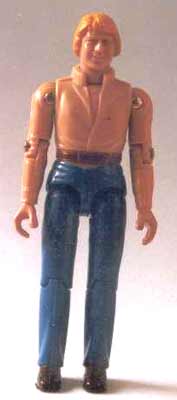
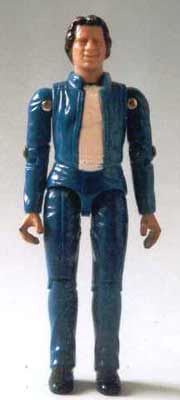
Bo and Luke Duke (Version 1)
For the Boys, Mego used the highly articulated body style that was used for lines such as The Black Hole and Buck Rogers.
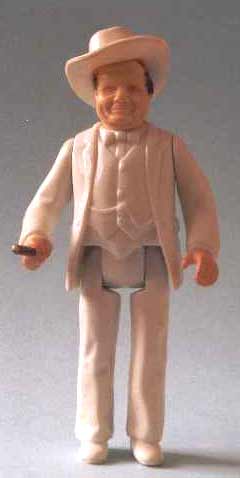
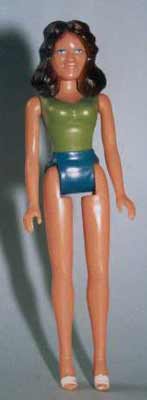
Boss Hogg and Daisy (although this is a later head sculpt) rounded out the first series. Boss had a Pocket heroes style body while Daisy emulated that of the Star Trek the motion picture line.
. 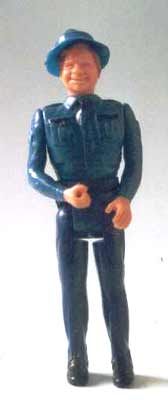
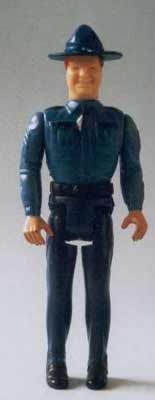
Roscoe and Cletus (pictured above) were in the second wave of figures and featured a body style similiar to the Pocket Superheroes. Mego fans will instantly noticed the recycled parts from CB McHaul.
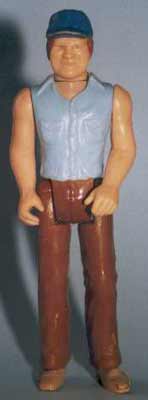
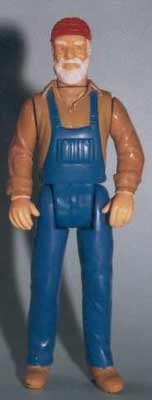
To round out the second series we have Cooter and Uncle Jesse, two figures that never made it to the 8″ format. Both figures can be tricky to find in the secondary market.
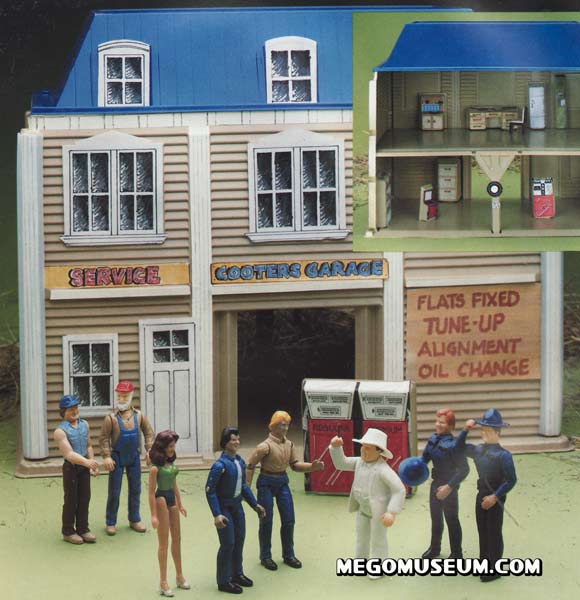
Mego featured a “Cooter’s Garage” playset in their 1982 catalog, as you can see by looking at the photo it’s a rather home made affair (the company was starting to struggle with R&D money) Despite the overwhelming popularity of the series at the time, it’s no surprise that buyers passed on this somewhat uninteresting playset. Without something that tied into the series (like being able to repair the vehicles) it’s just another vacuform shell.
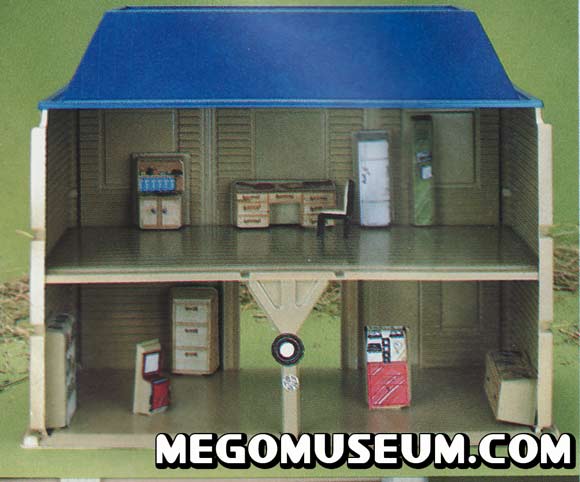
It’s all about the cars when you’re talking the Dukes and it’s high time we featured them. All photos are from the collection of Chris Johnson.
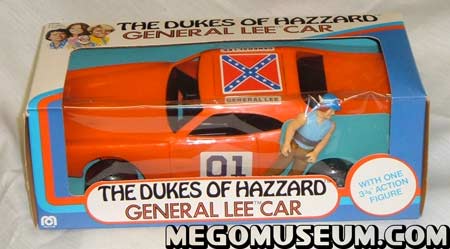
The General Lee came with a variety of bonus figures, often the Duke boys but occasionally characters like Uncle Jesse and Cooter as well.
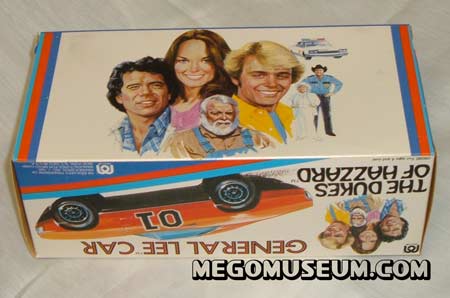
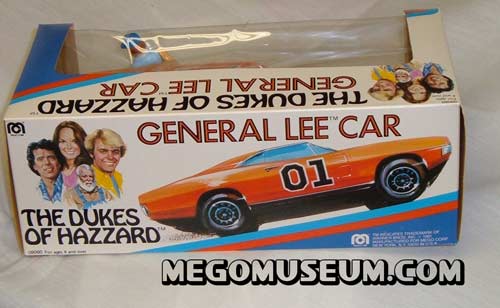

Daisy always came with her Jeep however.
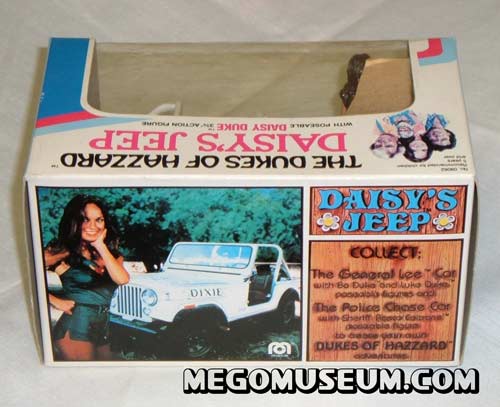

Catherine Bach was a strong selling point

